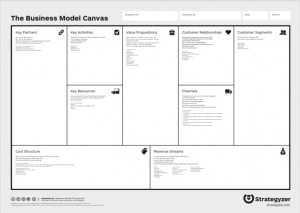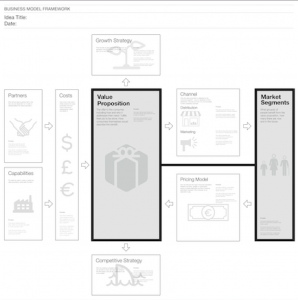The most common and widespread tool for developing and visualizing a business model is the Business Model Canvas, created by Alexander Osterwalder and Yves Pigneur.
The underlying idea is that a business model consists of nine building blocks:

Link to the original pdf template
These building blocks include: Value Propositions offered by the business, Customer Segments targeted by the business, Channels for delivering the value propositions, Customer Relationships maintained with each customer segment, Revenue Streams of exchanged value with customers, Key Resources as assets and Key Activities required to create, offer and deliver the value propositions, Key Partnerships for enabling value creation, and Cost Structure of the company’s inputs. This video is a good introduction to the Business Model Canvas.
Based on the „Business Model Ontology” developed in 2004 by Osterwalder, the Business Model Canvas was developed together with many practitioners and shared with a Creative Common Licence. The canvas can be seen as a checklist that helps you thinking about different aspects of a business model. As the structure of the canvas is fixed, the canvas can easily be applied to your situation by simply filling in the different blocks. The book „Business Model Generation“ explains this in more detail.
There are also different apps and web based tools which helps you to fill out the template – more about these will be discussed future blog posts,
Shortly before the publication of the business model canvas Patrick Stähler developed a canvas framework. One of the major differences in this canvas is the building block „Team & Values“. It focuses on the team, on competences and on core values of the company.
Since the development of the original Business Model Canvas, many other canvas tools have emerged as an expansion of the original. One example is the framework used by HackFWD for developing and pitching business models. They add two additional two perspectives are included: “Competitive Strategy” and “Growth Strategy“ – both interesting and important aspects that should be considered when creating a business model. Researchers, however, distinguish a business model from a business strategy (see Casadesus-Masanell & Ricart, 2010). HackFWD’s tool was introduced together with the Phase 2 Generator, where business models could be constructed, evaluated and shared. Although HackFWD unfortunately no longer exists, you can still be inspired by their work. This video by Tom Hulme is a great place to start.

Link to the original pdf template
There are many iterations of the original Business Model Canvas that incorporate different building blocks for creating a business model. Some examples are:
- Lean Canvas: focuses on building ideas and business models in conditions of uncertainty which startups often encounter. In such situations, Problem and the Solution as well as the Key Metrics are essential building blocks
- Social Business Model Canvas: helps design social businesses by adding Social Value, the Impact Measure or the Surplus. The latter refers to where profitable investments should be made.
- Business Model Architect Canvas: the Value Proposition building block is subdivided into Customer Value, Positioning, Price Level and Experience Cycle. Moreover, the Price Model is part of the building block Revenue Stream
- The Service Business Model Canvas: a theoretical approach that divides every building block of the Business Model Canvas into three layers – the Customer, Partner and Company Perspective
The Business Model Toolbox soon will provide a deeper overview on existing tools, their source, purpose, and fields of application.


I cannot thank you enough for the article post. Want more.
Thanks a lot! More is coming soon …
Best business template and explanation I’ve ever seen.
Polo